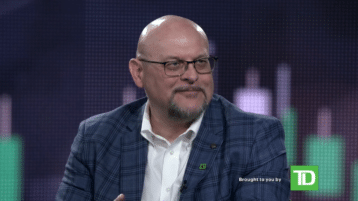David Siino, Managing Director, Portfolio Manager and Senior Analyst at TD Epoch, and Steven Bleiberg, Managing Director and Portfolio Manager at TD Epoch, are managers of the TD U.S. Capital Reinvestment Fund. They join Kim Parlee to discuss their approach to investing, including the importance of cash flow and why they believe ‘quality’ is often mispriced by the market.
Print Transcript
[AUDIO LOGO]
* Earlier this year, TD Asset Management announced that its affiliate, Epoch Investment Partners, would take over the management of its main US Blue Chip Equity Fund. Well, that change has happened on November 1. And with the name changing to TD US Capital Reinvestment Fund. And the two people now heading the fund are David Siino, Managing Director and Portfolio Manager and Senior Analyst, and Steven Bleiberg, Managing Director and Portfolio Manager, both at TD Epoch. And they're joining us from New York.
* Gentlemen, it is lovely to have you both with us. And I'm looking forward to the conversation to find out a little more. Steven, if I could, I'd like to start with you.
* This isn't the first time that I've spoken with somebody at TD Epoch. So I do know the importance of cash flow. And that's something that has always been very important. But maybe you could just tell us, remind us why you have that emphasis on cash flow over earnings.
* Sure, Kim. And thanks for having us. I think the best way to start is to tell you a story about my first day in business school, which was many, many years ago at this point. But I remember the first day of my introductory finance class in business school. The professor went up to the board, and he wrote two words on the board.
* And the two words were "time" and "uncertainty." And he said, "Finance is the study of how we value uncertain cash flows over time." And I think that's still the best definition of finance I've heard in all these years.
* Now, accounting is something quite different. And accounting is what produces things like an earnings per share number. But accountants have kind of a different view of the world than that finance view of the world, as we would call it. So for example, if I run a company and I go out and I build a factory and I spend $10 million to build that factory, the accountant will say to me, well, how long is that factory going to last?
* And if I say, 10 years, the accountant will say, OK, great. So we will charge a million dollars a year for 10 years against your revenues. Because accounting has this thing called the "matching principle," where they're trying to match up revenues and expenses over time, which is fine. It serves a certain purpose.
* But if you're trying to value the business and understand whether this company is doing well or not, it matters. The timing of the cash flow matters. It's not going to be $1 million a year going out the door for 10 years. That $10 million went out the door today to build the factory. And so, the timing of cash flows matters. That's why you should focus on how a business generates cash flow and also what they do with it.
* So our philosophy is basically sort of twofold. Number one is it's the ability of a business to generate not accounting earnings, but free cash flow that makes it worth something to begin with. And then equally importantly, it's what management does with that free cash flow that drives the value of the business up or down, meaning if they-- they can either, broadly speaking, either reinvest the cash flow into the business or give it back to the shareholders.
* If they're going to reinvest in the business, they should really only be doing that if they can earn a return on that investment that's greater than the cost of that capital. And when they run out of opportunities like that, the best use of the cash flow at that point is give it back to the shareholders, because they always have other things they can do with the money.
* We're just bringing up the chart now we have here about the founding principles of TD Epoch, as I mentioned, the free cash flows you talked about. And you were just talking about the ways that that cash flow can be deployed, whether it's reinvested in the business or paid out to shareholders. So much of this, I know, though, is when I spoke with you and your colleagues in the past too is about finding the cash flow is often very related to the quality of the companies that you look at. And quality, I know, is something that I believe that you think is important but is often, quote, "mispriced." Maybe you can tell us a bit about that.
* Sure. Well, quality in the investment business has traditionally meant three particular statistics. I mean, there are things like quality indices. And the way the companies that provide those indices determine who goes in is they vote for three particular statistical characteristics.
* One is high return on equity. Second is low leverage. Because one way you can boost your return on equity is if you just go out borrow some money, buy back some stock. The business hasn't changed. But now there's less equity. So a given level of profit will mean a higher return on equity. So the way you prevent that from happening is in terms of defining qualities, you say yes, high ROE, but with low leverage.
* And then the last thing that's usually used is earnings growth stability or stability of earnings. And our view is those are all nice things to have. And the companies that David and I look at in the fund that we're managing tend to have those characteristics. But to us, that's not enough.
* We think quality means more than just those statistical definitions. It has to do with two more things. One is what we were just talking about, that how does management allocate capital? Do they understand the principles of sensible capital allocation? Only reinvest when they can earn good returns on capital. Otherwise, return the money to shareholders.
* And the second one-- and I think more important-- is we're looking for businesses that have what we would call a sustainable competitive advantage. Sometimes people call it a moat. You want a business that is not just earning high returns on capital today, which is sort of the best measure of quality and profitability. But it's companies that do have some unique attributes to their business that are going to enable them to continue to earn high returns on capital going forward, regardless of what happens in markets.
* Sometimes you see companies like energy or commodities-type companies, where when the price of the underlying commodity goes up, their returns look good for a while. But they're not really in control of that. They're kind of at the mercy of the markets for setting the price of those commodities. And when the price inevitably comes down at some point in the future, their returns immediately deteriorate. So to us, that quality means that you have something that makes you unique, that gives you pricing power so that you can control your margins, control your returns on capital.
* I wouldn't mind, just maybe if we could, get into a little more detail about what you are looking at specifically when you're looking at what companies that you want to put into the portfolio. So Steve, I'll start with you again. What is the process or metrics you use when you are generating ideas?
* Sure. So we do think of ourselves as fundamental managers. But even no matter how fundamental you say you are, you have to have some way to narrow the universe down. There's thousands and thousands of stocks out there. You want to make sure that you're exercising your judgment most effectively, narrow the universe down to some set of companies that you can do a deep dive on, and be most effective in finding good performers.
* So we have a couple of tools that we use to get the process started. Basically, one is a screen, where you pass or you fail. And the other one is a sort of a ranking model. So there's a number of criteria we screen stocks for.
* Given what I was saying a moment ago, not surprising that number one is return on invested capital. We're looking for a premium over their cost of capital of at least 5%. We have a couple of growth metrics, which are not particularly heroic, basically. What they boil down to is we're looking for companies that can grow at least as fast as the economy or better.
* We're not demanding 10, 15, 20% growth. Just as long as you can keep up with the economy or do better, that's fine. And then we look for very high profit margins as well, because that's sort of a good way to screen out companies that are growing but just for growth's sake. And they're hurting their margins in the process of doing so.
* So that gets the universe down. That screens out about 90% of the names in the universe. Then we apply a proprietary ranking system we came up with. Looks at a whole bunch, almost two dozen different variables, most of them based on free cash flow metrics, basically looking for companies that are, as we've said, generating free cash flow, allocating it sensibly, ranks the stocks relative to their global industry peers.
* And that helps us narrow the universe down even further. So that starting from a US universe of 3 or 4 or 5,000 names, that gets us down to maybe 100 to 150 names, of which obviously, we already own some of them. But it gives us a smaller pool to work with to start doing a deep fundamental dive on those that David can tell you more about.
* All right, well, let's get to David then. So David, you've gotten the universe narrowed from, again, thousands to hundreds. And then, it's your choice to think about how do you go from being interested to actually adding it to portfolio. What do you look at?
* Sure. Good evening, Kim. And thanks again for having us on the program. So at a very high level, we ask ourselves two questions when we are considering a name. Those are how did we get here, and where are we going, how did we get here being, why does the company earn high returns on capital today? What are the advantages that it enjoys?
* Does it have a high margin business as most of our businesses do? Or is it a business that is a very efficient user of capital or ideally both? So in the how did we get here category, if it is a high margin business, we ask ourselves, well, does this company enjoy a price advantage, relative to its peers and why? Or does it enjoy a cost advantage relative to its peers, and why?
* That's the first part. That's fairly fundamental Finance 101, if you will. The harder question to answer is, where are we going? That is, how sustainable is the current level of profitability, as measured by returns on capital? How sustainable is that into the future and for how long?
* That is also a two-part question. The first thing we ask ourselves is, what is truly unique about this business? Does it have a technological advantage? Does it have, by definition, difficult to replicate physical assets? Does it have a very skilled management team? Does it have brand equity?
* Those are some of the things that make a business unique. That's good to be unique. Lots of businesses are unique.
* You may be able to see over my shoulder here the Empire State Building out of one of these windows. That is a unique property. But it is a fixed structure. It is not a growth property. The owners of that business cannot reinvest and make that building any taller.
* And this is the capital reinvestment strategy. So we need to identify opportunities that a business has, either organically or inorganically, to reinvest in their business and compound the terminal value of that business over time. We are mindful of risks, be they technological obsolescence, regulatory risk, risk of consumer tastes changing, risk of new entrants entering the company's line of business. All of those things, we need to be mindful of.
* Bad behavior by management is a big risk as measured by how they allocate capital. And to that end, we pay very close attention to how a management team is compensated. What are the KPIs that reward them?
* Are they growth-related, which are good? But is that growth that creates value? Is management incentivized to not just grow, but grow in a way that they earn a return on their capital greater than their cost of capital? So we are mindful--
* It's-- oh, go ahead. Sorry.
* Sorry. Go ahead, Kim.
* No, you go.
* OK, so the last piece of the puzzle is, we will not buy such a business at any price. We do take into consideration the percentage of a company's cash flow that it is reinvesting and at what rate of return we can expect to earn on that reinvestment. And we're willing to pay fair value for a great business, as opposed to paying a great price for a fair business that the old Charlie Munger axiom. So this is not an equality at any price strategy by any means. But we are willing to pay a fair value, with the belief that businesses that do earn a premium to their cost of capital will compound shareholder wealth over time.
* When you say it like that, it sounds-- I won't say simple. It sounds clear. And I'm sure it's so hard to do when you're actually trying to get out there and see all these things. I should let people know who are watching, we're going to give some examples of what that looks like in terms of some portfolio stocks that you own and maybe some of the ideas as to why.
* Before I do get to that, though-- and you mentioned a couple of these. I thought was just as interesting as why you're attracted to certain companies and bring them in. But probably the same conversation why they stay in, we have a chart here that-- and you mentioned something about management bad behavior
* I'm sure that's something that is keen on your radar to understand, do they want to stay there. But again, we're just looking at some of the reasons we have for selling a stock. So just even though it's gotten there, you're clear as to what it takes to remain there.
* Yeah, so we do sell stocks. We've spoken a lot about why we buy stocks, why we might sell them. You just mentioned one of them.
* I'd say one of the most frequent reasons we sell is because management misuses shareholders' money and misallocates capital, as is most evident in M&A, which not all M&A is bad. Most of it is. And if we hear a management team say, well, this deal is going to be accretive to earnings in year 2, well, that's great. But are you earning your cost of capital in year 2 or year 3?
* That's not so much a concern of ours if an acquisition is accretive to the bottom line. That's almost meaningless to us. We want to hear that management is at least thinking of its cost of capital when it is making acquisitions. And sometimes they make fairly large acquisitions that, in our view, we don't understand either the financial or the industrial logic of the transaction. So that is cause for us to sell.
* So another reason is simply the world changes. Owning a business in 2017 that has a visible patent cliff in 2023, we say, well, we have 6 years in front of us that are fairly visible. As you get closer to 2023, we're asking ourselves, is this still sustainable within our investment time horizon? And if say, a pharmaceutical company cannot fill that patent hole that is coming and is very visible in an economic way, that is another reason for us to sell.
[MUSIC PLAYING]
* Earlier this year, TD Asset Management announced that its affiliate, Epoch Investment Partners, would take over the management of its main US Blue Chip Equity Fund. Well, that change has happened on November 1. And with the name changing to TD US Capital Reinvestment Fund. And the two people now heading the fund are David Siino, Managing Director and Portfolio Manager and Senior Analyst, and Steven Bleiberg, Managing Director and Portfolio Manager, both at TD Epoch. And they're joining us from New York.
* Gentlemen, it is lovely to have you both with us. And I'm looking forward to the conversation to find out a little more. Steven, if I could, I'd like to start with you.
* This isn't the first time that I've spoken with somebody at TD Epoch. So I do know the importance of cash flow. And that's something that has always been very important. But maybe you could just tell us, remind us why you have that emphasis on cash flow over earnings.
* Sure, Kim. And thanks for having us. I think the best way to start is to tell you a story about my first day in business school, which was many, many years ago at this point. But I remember the first day of my introductory finance class in business school. The professor went up to the board, and he wrote two words on the board.
* And the two words were "time" and "uncertainty." And he said, "Finance is the study of how we value uncertain cash flows over time." And I think that's still the best definition of finance I've heard in all these years.
* Now, accounting is something quite different. And accounting is what produces things like an earnings per share number. But accountants have kind of a different view of the world than that finance view of the world, as we would call it. So for example, if I run a company and I go out and I build a factory and I spend $10 million to build that factory, the accountant will say to me, well, how long is that factory going to last?
* And if I say, 10 years, the accountant will say, OK, great. So we will charge a million dollars a year for 10 years against your revenues. Because accounting has this thing called the "matching principle," where they're trying to match up revenues and expenses over time, which is fine. It serves a certain purpose.
* But if you're trying to value the business and understand whether this company is doing well or not, it matters. The timing of the cash flow matters. It's not going to be $1 million a year going out the door for 10 years. That $10 million went out the door today to build the factory. And so, the timing of cash flows matters. That's why you should focus on how a business generates cash flow and also what they do with it.
* So our philosophy is basically sort of twofold. Number one is it's the ability of a business to generate not accounting earnings, but free cash flow that makes it worth something to begin with. And then equally importantly, it's what management does with that free cash flow that drives the value of the business up or down, meaning if they-- they can either, broadly speaking, either reinvest the cash flow into the business or give it back to the shareholders.
* If they're going to reinvest in the business, they should really only be doing that if they can earn a return on that investment that's greater than the cost of that capital. And when they run out of opportunities like that, the best use of the cash flow at that point is give it back to the shareholders, because they always have other things they can do with the money.
* We're just bringing up the chart now we have here about the founding principles of TD Epoch, as I mentioned, the free cash flows you talked about. And you were just talking about the ways that that cash flow can be deployed, whether it's reinvested in the business or paid out to shareholders. So much of this, I know, though, is when I spoke with you and your colleagues in the past too is about finding the cash flow is often very related to the quality of the companies that you look at. And quality, I know, is something that I believe that you think is important but is often, quote, "mispriced." Maybe you can tell us a bit about that.
* Sure. Well, quality in the investment business has traditionally meant three particular statistics. I mean, there are things like quality indices. And the way the companies that provide those indices determine who goes in is they vote for three particular statistical characteristics.
* One is high return on equity. Second is low leverage. Because one way you can boost your return on equity is if you just go out borrow some money, buy back some stock. The business hasn't changed. But now there's less equity. So a given level of profit will mean a higher return on equity. So the way you prevent that from happening is in terms of defining qualities, you say yes, high ROE, but with low leverage.
* And then the last thing that's usually used is earnings growth stability or stability of earnings. And our view is those are all nice things to have. And the companies that David and I look at in the fund that we're managing tend to have those characteristics. But to us, that's not enough.
* We think quality means more than just those statistical definitions. It has to do with two more things. One is what we were just talking about, that how does management allocate capital? Do they understand the principles of sensible capital allocation? Only reinvest when they can earn good returns on capital. Otherwise, return the money to shareholders.
* And the second one-- and I think more important-- is we're looking for businesses that have what we would call a sustainable competitive advantage. Sometimes people call it a moat. You want a business that is not just earning high returns on capital today, which is sort of the best measure of quality and profitability. But it's companies that do have some unique attributes to their business that are going to enable them to continue to earn high returns on capital going forward, regardless of what happens in markets.
* Sometimes you see companies like energy or commodities-type companies, where when the price of the underlying commodity goes up, their returns look good for a while. But they're not really in control of that. They're kind of at the mercy of the markets for setting the price of those commodities. And when the price inevitably comes down at some point in the future, their returns immediately deteriorate. So to us, that quality means that you have something that makes you unique, that gives you pricing power so that you can control your margins, control your returns on capital.
* I wouldn't mind, just maybe if we could, get into a little more detail about what you are looking at specifically when you're looking at what companies that you want to put into the portfolio. So Steve, I'll start with you again. What is the process or metrics you use when you are generating ideas?
* Sure. So we do think of ourselves as fundamental managers. But even no matter how fundamental you say you are, you have to have some way to narrow the universe down. There's thousands and thousands of stocks out there. You want to make sure that you're exercising your judgment most effectively, narrow the universe down to some set of companies that you can do a deep dive on, and be most effective in finding good performers.
* So we have a couple of tools that we use to get the process started. Basically, one is a screen, where you pass or you fail. And the other one is a sort of a ranking model. So there's a number of criteria we screen stocks for.
* Given what I was saying a moment ago, not surprising that number one is return on invested capital. We're looking for a premium over their cost of capital of at least 5%. We have a couple of growth metrics, which are not particularly heroic, basically. What they boil down to is we're looking for companies that can grow at least as fast as the economy or better.
* We're not demanding 10, 15, 20% growth. Just as long as you can keep up with the economy or do better, that's fine. And then we look for very high profit margins as well, because that's sort of a good way to screen out companies that are growing but just for growth's sake. And they're hurting their margins in the process of doing so.
* So that gets the universe down. That screens out about 90% of the names in the universe. Then we apply a proprietary ranking system we came up with. Looks at a whole bunch, almost two dozen different variables, most of them based on free cash flow metrics, basically looking for companies that are, as we've said, generating free cash flow, allocating it sensibly, ranks the stocks relative to their global industry peers.
* And that helps us narrow the universe down even further. So that starting from a US universe of 3 or 4 or 5,000 names, that gets us down to maybe 100 to 150 names, of which obviously, we already own some of them. But it gives us a smaller pool to work with to start doing a deep fundamental dive on those that David can tell you more about.
* All right, well, let's get to David then. So David, you've gotten the universe narrowed from, again, thousands to hundreds. And then, it's your choice to think about how do you go from being interested to actually adding it to portfolio. What do you look at?
* Sure. Good evening, Kim. And thanks again for having us on the program. So at a very high level, we ask ourselves two questions when we are considering a name. Those are how did we get here, and where are we going, how did we get here being, why does the company earn high returns on capital today? What are the advantages that it enjoys?
* Does it have a high margin business as most of our businesses do? Or is it a business that is a very efficient user of capital or ideally both? So in the how did we get here category, if it is a high margin business, we ask ourselves, well, does this company enjoy a price advantage, relative to its peers and why? Or does it enjoy a cost advantage relative to its peers, and why?
* That's the first part. That's fairly fundamental Finance 101, if you will. The harder question to answer is, where are we going? That is, how sustainable is the current level of profitability, as measured by returns on capital? How sustainable is that into the future and for how long?
* That is also a two-part question. The first thing we ask ourselves is, what is truly unique about this business? Does it have a technological advantage? Does it have, by definition, difficult to replicate physical assets? Does it have a very skilled management team? Does it have brand equity?
* Those are some of the things that make a business unique. That's good to be unique. Lots of businesses are unique.
* You may be able to see over my shoulder here the Empire State Building out of one of these windows. That is a unique property. But it is a fixed structure. It is not a growth property. The owners of that business cannot reinvest and make that building any taller.
* And this is the capital reinvestment strategy. So we need to identify opportunities that a business has, either organically or inorganically, to reinvest in their business and compound the terminal value of that business over time. We are mindful of risks, be they technological obsolescence, regulatory risk, risk of consumer tastes changing, risk of new entrants entering the company's line of business. All of those things, we need to be mindful of.
* Bad behavior by management is a big risk as measured by how they allocate capital. And to that end, we pay very close attention to how a management team is compensated. What are the KPIs that reward them?
* Are they growth-related, which are good? But is that growth that creates value? Is management incentivized to not just grow, but grow in a way that they earn a return on their capital greater than their cost of capital? So we are mindful--
* It's-- oh, go ahead. Sorry.
* Sorry. Go ahead, Kim.
* No, you go.
* OK, so the last piece of the puzzle is, we will not buy such a business at any price. We do take into consideration the percentage of a company's cash flow that it is reinvesting and at what rate of return we can expect to earn on that reinvestment. And we're willing to pay fair value for a great business, as opposed to paying a great price for a fair business that the old Charlie Munger axiom. So this is not an equality at any price strategy by any means. But we are willing to pay a fair value, with the belief that businesses that do earn a premium to their cost of capital will compound shareholder wealth over time.
* When you say it like that, it sounds-- I won't say simple. It sounds clear. And I'm sure it's so hard to do when you're actually trying to get out there and see all these things. I should let people know who are watching, we're going to give some examples of what that looks like in terms of some portfolio stocks that you own and maybe some of the ideas as to why.
* Before I do get to that, though-- and you mentioned a couple of these. I thought was just as interesting as why you're attracted to certain companies and bring them in. But probably the same conversation why they stay in, we have a chart here that-- and you mentioned something about management bad behavior
* I'm sure that's something that is keen on your radar to understand, do they want to stay there. But again, we're just looking at some of the reasons we have for selling a stock. So just even though it's gotten there, you're clear as to what it takes to remain there.
* Yeah, so we do sell stocks. We've spoken a lot about why we buy stocks, why we might sell them. You just mentioned one of them.
* I'd say one of the most frequent reasons we sell is because management misuses shareholders' money and misallocates capital, as is most evident in M&A, which not all M&A is bad. Most of it is. And if we hear a management team say, well, this deal is going to be accretive to earnings in year 2, well, that's great. But are you earning your cost of capital in year 2 or year 3?
* That's not so much a concern of ours if an acquisition is accretive to the bottom line. That's almost meaningless to us. We want to hear that management is at least thinking of its cost of capital when it is making acquisitions. And sometimes they make fairly large acquisitions that, in our view, we don't understand either the financial or the industrial logic of the transaction. So that is cause for us to sell.
* So another reason is simply the world changes. Owning a business in 2017 that has a visible patent cliff in 2023, we say, well, we have 6 years in front of us that are fairly visible. As you get closer to 2023, we're asking ourselves, is this still sustainable within our investment time horizon? And if say, a pharmaceutical company cannot fill that patent hole that is coming and is very visible in an economic way, that is another reason for us to sell.
[MUSIC PLAYING]


























